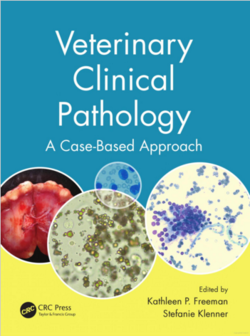Difference between revisions of "Book Review: Veterinary Clinical Pathology, A Case-Based Approach, Freeman and Klenner"
(No difference)
| |
Latest revision as of 08:37, 12 April 2018
The book has a total of 200 cases covering majority small animals but also farm and equine. The cases are well thought out with a brief history and any relevant lab tests (blood work, urinalysis, blood smears, further tests) before a question section to help you diagnose the patient. Some of the cases are fairly straightforward whereas some are more challenging. All reference ranges are included in every case and any abnormal results are in bold, helping you to quickly identify which results you need to focus on. The images are all very clear and are very indicative of what you would see in practise. There is an explanatory note with all images stating where the sample is from, the magnification and staining used.
The answers to all the cases are in the second half of the book. They are very useful; explaining all abnormal findings with extra information about the case, follow up sections and references for further reading. I did find the answers being separate slightly annoying at first as you were constantly flipping back and forth between the two, but did find I was more likely to answer the questions myself before looking them up than if they were at the bottom of the page!
I feel the book is most beneficial to students in the clinical years of their course or general practitioners wanting to brush up on their pathology skills with some of the more advanced cases. It works for study alone or in a group using the questions as a discussion point.
I personally love this book – it has helped me become more confident in interpreting lab results and I have been able to put this into practice on my placements. I took it onto my EMS with me, and both the vets and nurses loved it, and were quizzing each other on the cases! The only downside to the book I really have, is that the small, equine and farm cases are all mixed in together – it is quite frustrating and time consuming if you want to focus on one species as you have to flick though the cases to find the relevant ones. Overall, however, I would definitely recommend it- especially if you are unsure and are wanting more practice interpreting lab results in a case based setting.
| This book was reviewed by: Date reviewed: March 2016 |
Error in widget FBRecommend: unable to write file /var/www/wikivet.net/extensions/Widgets/compiled_templates/wrt677d5d4bc083a0_85046617 Error in widget google+: unable to write file /var/www/wikivet.net/extensions/Widgets/compiled_templates/wrt677d5d4bc83592_82130588 Error in widget TwitterTweet: unable to write file /var/www/wikivet.net/extensions/Widgets/compiled_templates/wrt677d5d4bceff07_92021833
|
| WikiVet® Introduction - Help WikiVet - Report a Problem |
